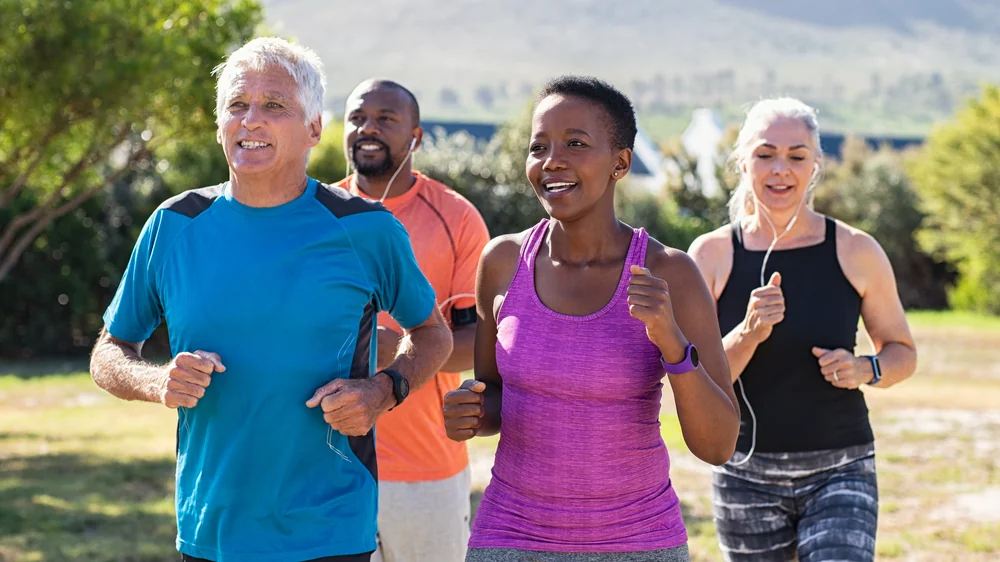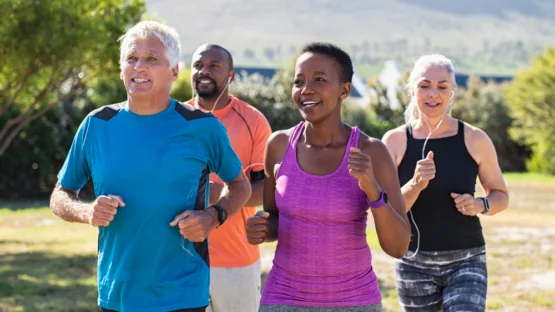Using a DNA methylation clock based on fitness, researchers publishing in GeroScience have determined that people who exercise regularly are biologically younger on average [1].
Chronological and biological aging
The number of candles on a birthday cake mark a person’s chronological age, but that person’s biological age could be very different, as it is affected by such things as lifestyle and environment.
As people age, their DNA changes. It doesn’t only acquire mutations; its methylation pattern also changes. DNA methylation is a chemical modification of the DNA, as it consists of a methyl group added to specific parts. This modification does not change the genetic code. However, DNA methylation impacts which genes stay active and which ones are not active [2].
With age, methylation patterns change and affect the activity of different genes [2]. Different activities, like exercise, can impact the speed of those changes.
Researchers use that knowledge in designing aging clocks, which can assess how closely someone’s chronological age matches that person’s biological age along with their rate of aging and mortality risk. These clocks are constantly being refined with scientific advancements.
A new advancement in physical measurements
Recently, researchers created DNAmFitAge, a new version of an aging clock [3]. This clock is based on the relationship between physical fitness and biological aging. It was built using three specific physical fitness measurements: maximal oxygen uptake, maximal gripping force (maximum handgrip strength), and gait speed (walking speed).
These researchers used that clock along with other physical measurements. They included relative jumping distance, body mass index, blood LDL and HDL, and blood irisin (a hormone released by muscles upon exercise). They tested the clock on 303 healthy and athletic people aged 33 to 88 and found that it more accurately reflected exercise-related changes than other clocks.
Physical fitness and methylation status
Participants were divided into groups based on their fitness levels, and all of these groups showed a decline in all of these measured functions with age. However, some of these functions differed between groups. For example, HDL levels differed between high-fit and low/medium-fit groups of males and females.
People in the high-fit group had with younger biological ages, lower BMIs, better physical health measurements, and higher HDL levels. Therefore, this paper provides new evidence for the idea that physical exercise is related to the physiological and methylation aspects of aging.
Cognitive function
A breadth of research supports that there is a positive impact of physical exercise on cognitive function [4]. Therefore, these researchers assessed the verbal short-term memory of study participants.
Younger, leaner, and more physically fit individuals obtained the best scores for short-term memory tests. The researchers observed that better short-term memory was associated with higher levels of maximal oxygen consumption, improved physical strength measurements, and better HDL levels. DNAmFitAge is also negatively correlated with short-term memory test scores, meaning that biologically younger people, according to this clock, have better memory.
Active people are biologically younger
According to the clock and measurements used in this study, highly active individuals are, on average, 1.5 years (for females) and 2.0 years (for males) biologically younger than other people.
The authors point out that the control group that they used, which consisted of individuals with low or medium levels of exercise, is above the average of the general population. Therefore, people who exercise regularly may have an even younger average biological age than people who do not exercise at all, but this remains to be tested.
This research adds more evidence to the hypothesis that regular exercise is beneficial for health and can slow down aging.
Literature
[1] Jokai, M., Torma, F., McGreevy, K. M., Koltai, E., Bori, Z., Babszki, G., Bakonyi, P., Gombos, Z., Gyorgy, B., Aczel, D., Toth, L., Osvath, P., Fridvalszky, M., Teglas, T., Posa, A., Kujach, S., Olek, R., Kawamura, T., Seki, Y., Suzuki, K., … Radak, Z. (2023). DNA methylation clock DNAmFitAge shows regular exercise is associated with slower aging and systemic adaptation. GeroScience, 10.1007/s11357-023-00826-1. Advance online publication.
[2] Johnson, A. A., Akman, K., Calimport, S. R., Wuttke, D., Stolzing, A., & de Magalhães, J. P. (2012). The role of DNA methylation in aging, rejuvenation, and age-related disease. Rejuvenation research, 15(5), 483–494.
[3] McGreevy, K. M., Radak, Z., Torma, F., Jokai, M., Lu, A. T., Belsky, D. W., Binder, A., Marioni, R. E., Ferrucci, L., Pospiech, E., Branicki, W., Ossowski, A., Sitek, A., Spólnicka, M., Raffield, L. M., Reiner, A. P., Cox, S., Kobor, M., Corcoran, D. L., & Horvath, S. (2023). DNAmFitAge: biological age indicator incorporating physical fitness. Aging, 15(10), 3904–3938.
[4] Mandolesi, L., Polverino, A., Montuori, S., Foti, F., Ferraioli, G., Sorrentino, P., & Sorrentino, G. (2018). Effects of Physical Exercise on Cognitive Functioning and Wellbeing: Biological and Psychological Benefits. Frontiers in psychology, 9, 509.




